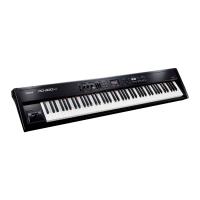What to do if my Roland Musical Instrument displays error 16?
- NNicole WalkerSep 13, 2025
If the Roland Musical Instrument displays error 16, data couldn't be read fast enough for playback. Wait a few seconds, and then try to play the song again.

What to do if my Roland Musical Instrument displays error 16?
If the Roland Musical Instrument displays error 16, data couldn't be read fast enough for playback. Wait a few seconds, and then try to play the song again.
| Max Polyphony | 128 voices |
|---|---|
| Metronome | Yes |
| Keyboard | 88 keys |
| Sound Generator | SuperNATURAL Piano |
| Effects | Reverb, Chorus, 3-band EQ |
| Display | 128 x 64 dots graphic LCD |
| Power Supply | AC Adaptor |
| Connectors | Output jacks (L/MONO, R), Input jacks (L/MONO, R), MIDI connectors (IN, OUT), USB COMPUTER port, USB MEMORY port |
| Included Accessories | Owner's Manual, AC Adaptor, Power Cord, Damper Pedal |
Explains the meaning of WARNING and CAUTION notices for safe operation.
Provides crucial safety instructions for preventing hazards like fire, shock, and injury.
Covers essential guidelines for connecting and using the power supply safely and correctly.
Details optimal placement of the unit to prevent damage and ensure proper ventilation.
Provides instructions for cleaning and maintaining the unit to ensure longevity and performance.
Details the layout and function of all controls on the RD-300NX's front panel.
Identifies and explains the function of each connector and switch on the RD-300NX's rear panel.
Provides instructions for securely mounting the RD-300NX on its designated stand.
Details the steps for correctly connecting the AC power adapter for safe operation.
Explains how to connect audio and MIDI devices, headphones, and pedals to the unit.
Provides the correct procedure for powering the RD-300NX on and off to prevent damage.
Explains the RD-300NX's division into controller and sound generator sections.
Introduces Live Sets as stored sound configurations and their organization into banks.
Explains the main operational screens: One Touch, Live Set, and MIDI screens.
Guides on using the PIANO and E. PIANO buttons for quick piano sound selection.
Details how to activate Dual Mode to layer UPPER 1 and UPPER 2 tones across the keyboard.
Explains Split Mode for playing different tones in the left and right keyboard sections.
Introduces the built-in drum patterns (Rhythms) available on the RD-300NX.
Guides on playing back SMF music files, audio data, or CD tracks.
Explains how to apply multi-effects (MFX) to sounds for various sonic modifications.
Provides step-by-step instructions for saving custom settings as new Live Sets in the user bank.
Guides on adjusting specific parameters for Piano One Touch Tones.
Lists and describes parameters for detailed adjustment of piano sounds.
Explains how to adjust the keyboard's touch sensitivity for different playing styles.
Guides on making detailed adjustments to assigned tones for each layer.
Explains how to make detailed settings for each layer (UP1, UP2, LOWER), including volume, pan, transpose, and key range.
Identifies and explains the functions of the RD-300NX's MIDI IN and OUT connectors.
Guides on using LAYER LEVEL sliders to adjust the volume of external layers.
Guides on setting the MIDI transmit channel for each layer to match external devices.
Explains how to select tones on external MIDI devices using Bank Select and Program Change messages.
Details how to adjust volume and panning for individual layers in MIDI transmissions.
Explains how to set individual transposition for each layer sent via MIDI.
Guides on setting the key range for each layer transmitted via MIDI.
Explains how to enable or disable control from pedals, levers, and buttons for MIDI transmission.
Introduces the MENU button for accessing various system and function settings.
Guides on configuring system-wide settings like Master Tune, Volume, and Pedal Mode.
Explains how to adjust the RD-300NX's pitch to match other instruments.
Explains how to set pedal polarity to ensure correct operation with different pedals.
Guides on recording RD-300NX performances to an external MIDI sequencer.
Explains the function of the Local Switch in managing MIDI connections and sound generation.
Guides on controlling the RD-300NX's internal sound generator from an external MIDI device.
Guides on connecting the RD-300NX to a computer using a USB MIDI connector.
Guides on selecting and installing the appropriate USB driver for computer connection.
Provides solutions to common problems encountered while using the RD-300NX.
Lists and explains various error indications and their corresponding actions.
Provides a comprehensive list of all available Multi-Effects (MFX), Chorus, and Reverb types.